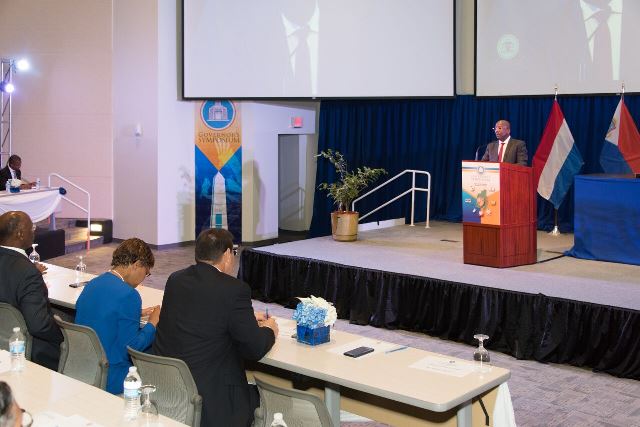The topic of this Forum calls for a re-thinking and re-imagining of what a future St. Maarten should be like in terms of its use and integration of Information Technology in its everyday life. We could look at this from the perspective of government’s IT Department and what the policy is with regards to harvesting the fruits of technology for the benefit of the people. I am, however, sure that there are better qualified experts who will address this point of view.
Permit me, therefore, to take a broader view of the issue and share with you my vision of St. Maarten in the next generation.
All over the island, from school children to senior citizens, the Smart phone has become a commonplace gadget. I understand that by last year there were over a billion of them all across the globe. This means a dramatic change not only in how we communicate with one another, but also a total restructuring of our lives and even our society with smart phones as the driving vector.
Smart phones have become so indispensable that we do not leave home without them. We could forget our keys, forget our wrist-watch or even our glasses and still drive off to wherever we may be going, but we would turn back immediately if we should forget our smart phone. Of course, the debate still rages on whether this is so smart of us.
But while there is no denying the fact that the smart phone has become almost as essential as the air we breathe, the question becomes, along with this smart phone, and the smart technology, do we have smart users, or smart citizens?
I ask this in view of the fact that I envision St. Maarten as a Smart City or a Smart Island in the not-too-distant future. Yes, ladies and gentlemen, St. Maarten can become a Smart City by the next generation.
What is a Smart City, you may ask?
According to Andrea Caragliu and Peter Nijkamp, in a 2009 paper entitled, “Smart Cities in Europe,” “A city is defined as smart when investments in human and social capital and traditional (transport) and modern (ICT) communication infrastructure fuel sustainable development and a high quality of life, with a wise management of natural resources, through participatory action…”
For Eduardo da Costa Paes, the former mayor of Rio de Janeiro, “Smart cities are those who manage their resources efficiently. Traffic, public services and disaster response should be operated intelligently in order to minimize costs, reduce carbon emissions and increase performance.”
The ultimate purpose of a smart city, in my humble view, is indeed to marry infrastructure to the needs of the people in such a way that it facilitates fair and equal access to government services, and significantly reduces bureaucracy while greatly enhancing participation of the citizenry.
In other words, a smart city employs digital technology to improve the lives of the people that reside in it. For this to happen, government must be able to offer strategic leadership not only by embracing technology and innovation but also by encouraging and nurturing the creativity of its citizens, especially the young and talented tech entrepreneurs.
This brings me to the question Shakespeare posed in one of his lesser known plays, “What is the city but the people?” Or translated into our today’s language, what is a smart city without smart people?
The investment that is required in human capital means that we should redesign our educational system in order for it to be able to produce “smart” people without whom there can be no smart city. In fact, a smart city is known by its ability to attract and keep knowledgeable citizens. Amsterdam, one of Europe’s smart cities, is also a knowledge city that boasts twenty-one universities of applied sciences with 40% of its population having higher education.
We will also need to invest, of course, in technology. This requires a huge financial outlay over a period of time. Needless to say government does not have that financial possibility at the moment. But we cannot shy away from ensuring that we have enough capacity and backbone as well as high-speed Internet in all corners of St. Maarten if we want to transform the island into a Smart City.
We need to adopt an effective and efficient use of technology not only in government administration, but also in our schools, banks, businesses, health care, traffic and security services. Only an effective public-private partnership will enable us achieve such a goal.
I am convinced, however, that we shall get there if we follow a road map using the famous PPT – People, Processes and Technology in a creative way.
This means that we must study our people to determine their real needs, and understand their uniqueness as well as their ideals and goals in life: Then we will have to develop a Smart City Policy and design plans and strategies on how the goals will be achieved. All of this must be done through an intensive involvement of the people in a transparent and easy manner that can be strengthened through the use of technology, for example, e-government.
Wouldn’t it be a great leap into the future for St. Maarten if our citizens could file their taxes online, and apply for government permits, shop for groceries and receive their medical reports on their smart phones? Wouldn’t it make government more responsive if people could offer suggestions and file complaints directly to the various ministries and receive responses within hours? I guess that is what the minister of VROMI, the honorable Christophe Emmanuel, had in mind when he launched the new App recently that would give the public direct access to officials in his ministry.
What I am talking about is, of course, a paperless government serving a very wired community. It is the future our children deserve. It is the direction we have to go if we don’t want to be left behind in this 21st Century.





























